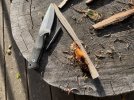BlindMouse2of3
Gold Member
- Joined
- May 15, 2008
- Messages
- 1,610
Below 8cr is where I draw the line for an active user knife. I have a few small Kershaw's in 8cr and they are just fine for what they are. Cheap and easy to resharpen corrosion resistant within reason. They loose the edge just as fast as they take a new one. Aus8, vg10, 440b, 440c, n690, and a plethora of others are easy to consider inferior but they are also easy to touch up on the sharpmaker at work while taking lunch.
I didn't know my grandparents but I would say this is probably spot on.As for 440C, I think about the steel my grandparents knew (I’m old, so this was a while ago), and they’d have rightly seen 440C as an incredibly balanced but affordable wonder material. It does the job.

